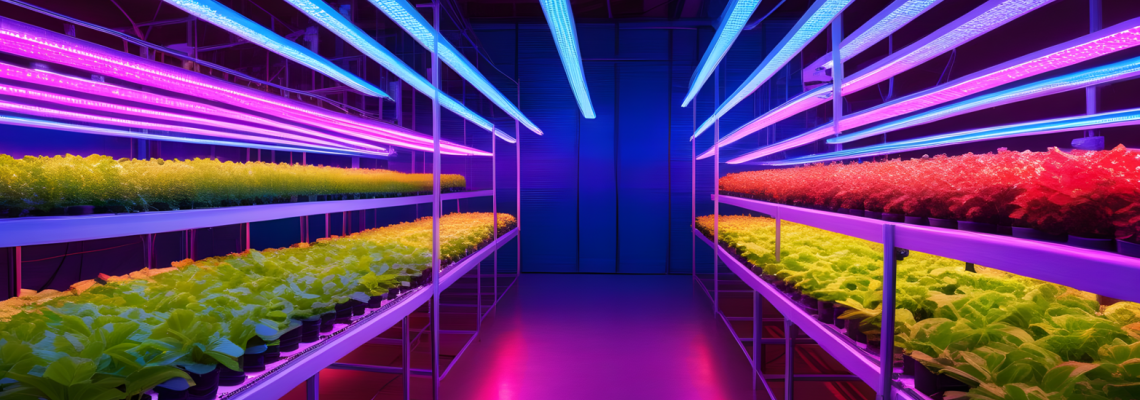
Over the past decade, indoor farming has rapidly progressed from a niche concept to a vital solution for sustainable food production. As global demand for fresh, local produce rises and climate challenges intensify, growers are turning to controlled environments to cultivate crops more efficiently. One of the key drivers of this transformation is lighting, specifically, full-spectrum LED grow lights. In 2025, these advanced lighting systems will play a pivotal role in revolutionizing indoor farming. Designed to replicate the natural sunlight plants need for photosynthesis, full-spectrum LEDs provide balanced wavelengths that support every stage of plant growth—from seedling to harvest. Whether in vertical farms housed in urban warehouses or state-of-the-art greenhouses in rural areas, these LEDs are delivering higher yields, reducing energy costs, and promoting sustainable growing practices. Their energy efficiency, low heat output, and ability to be customized for different crop types make them an ideal solution for modern agriculture.
This blog explores how full-spectrum LED grow lights are reshaping the future of indoor farming, making it smarter, more productive, and more sustainable for growers worldwide.
What Are Full-Spectrum LED Grow Lights?
Full-spectrum LED grow lights mimic the natural sunlight required for healthy plant growth. Unlike traditional grow lights that emit only red or blue wavelengths, full-spectrum LEDs provide a balanced mix of all the wavelengths of light—visible and beyond—that plants use in photosynthesis and development.
This includes:
Blue light (400–500 nm): Promotes strong root and vegetative growth.
Red light (600–700 nm): Stimulates flowering and fruiting.
Green light (500–600 nm): Penetrates deeper into the plant canopy.
Far-red and UV light: Influences flowering cycles and nutrient uptake.
By replicating the complete light spectrum, these LEDs offer a more natural and efficient lighting solution for indoor crops.
Top Benefits of Full-Spectrum LEDs in Indoor Farming
1. Enhanced Plant Growth and Yield
In 2025, growers are seeing 20–40% increases in yield using full-spectrum LEDs compared to older lighting technologies. By supplying light that supports every stage of a plant’s lifecycle, these LEDs help optimize photosynthesis, boost nutrient absorption, and reduce plant stress.
Whether it's leafy greens, tomatoes, strawberries, or herbs, full-spectrum lighting ensures healthier, more robust crops.
2. Energy Efficiency and Cost Savings
Modern full-spectrum LEDs are incredibly energy-efficient. They convert more energy into usable light with less heat output, reducing both electricity usage and cooling costs. Many commercial farms in 2025 have transitioned entirely to LED systems, cutting energy costs by up to 50%.
Plus, their long lifespan (often 50,000+ hours) minimizes replacement and maintenance expenses.
3. Year-Round Growing
Indoor farming frees growers from seasonal limitations, and full-spectrum LEDs are key to that freedom. With consistent, controllable lighting conditions, farmers can cultivate crops 365 days a year, regardless of climate or location.
This reliability is especially critical in urban areas and regions with limited arable land or harsh weather conditions.
4. Precise Control Over Plant Development
Full-spectrum LED systems in 2025 come with smart controls and dimmable settings, allowing growers to fine-tune light intensity and spectrum at each growth stage. Want more blue light for seedlings or a red-heavy spectrum for flowering? It’s just a click away.
This precision improves quality, shortens growth cycles, and allows for better experimentation and crop customization.
5. Lower Heat Output
Unlike HID and fluorescent lights, LEDs emit very little heat. This reduces the risk of plant damage and allows lights to be placed closer to crops, maximizing usable space in vertical farms.
Lower heat also means less dependence on HVAC systems, saving energy and preserving a more stable growing environment.
Real-World Applications in 2025
Here are some of the ways full-spectrum LEDs are being used to reshape farming today:
Urban Vertical Farms
Full-spectrum LED grow lights are the backbone of vertical farms in cities like Singapore, New York, and Tokyo. These stacked growing systems use minimal space and produce fresh vegetables right where demand is highest.
LEDs enable these farms to function without natural sunlight, making them truly independent and scalable.
Research & Biotech Farming
Biotech companies are using full-spectrum lighting in labs to grow pharmaceutical plants and genetically modified crops in controlled environments. The uniform, predictable light spectrum ensures consistent growth for experimental and high-value plants.
Remote & Off-Grid Farming
In areas with unreliable electricity or limited natural light, solar-powered LED systems provide a sustainable growing solution. Combined with hydroponics or aeroponics, they create low-resource, high-output systems ideal for developing regions or space-limited environments.
Integration With Smart Farming Technologies
In 2025, full-spectrum LEDs are often paired with IoT systems, AI-driven monitoring tools, and environmental sensors. This integration enables:
Automated light schedules based on crop type and growth stage.
Remote control and monitoring via smartphone apps.
Energy optimization based on real-time weather and power costs.
AI feedback loops to adjust spectrum and intensity based on plant health.
These features make full-spectrum LED systems smarter and more efficient than ever, allowing even small-scale farmers to compete with industrial producers.
LED vs Traditional Grow Lights: A Quick Comparison
Sustainability and the Future of Farming
The global push for climate-friendly agriculture makes full-spectrum LEDs more important than ever. By lowering carbon footprints, reducing water usage, and increasing food security in cities, these lights are a key part of the future of sustainable farming. Governments and organizations worldwide are offering energy rebates and incentives for farms that adopt LED technology, making the transition even more attractive in 2025.
Conclusion
Full-spectrum LED grow lights have moved far beyond being a trend—they are now a core technology shaping the future of agriculture. In 2025, they empower farmers to grow better, smarter, and more sustainably in any environment.
Whether you're a commercial greenhouse operator, an indoor farming entrepreneur, or a hobby grower, adopting full-spectrum LED lighting could be the smartest move you make this year.

Leave a Comment